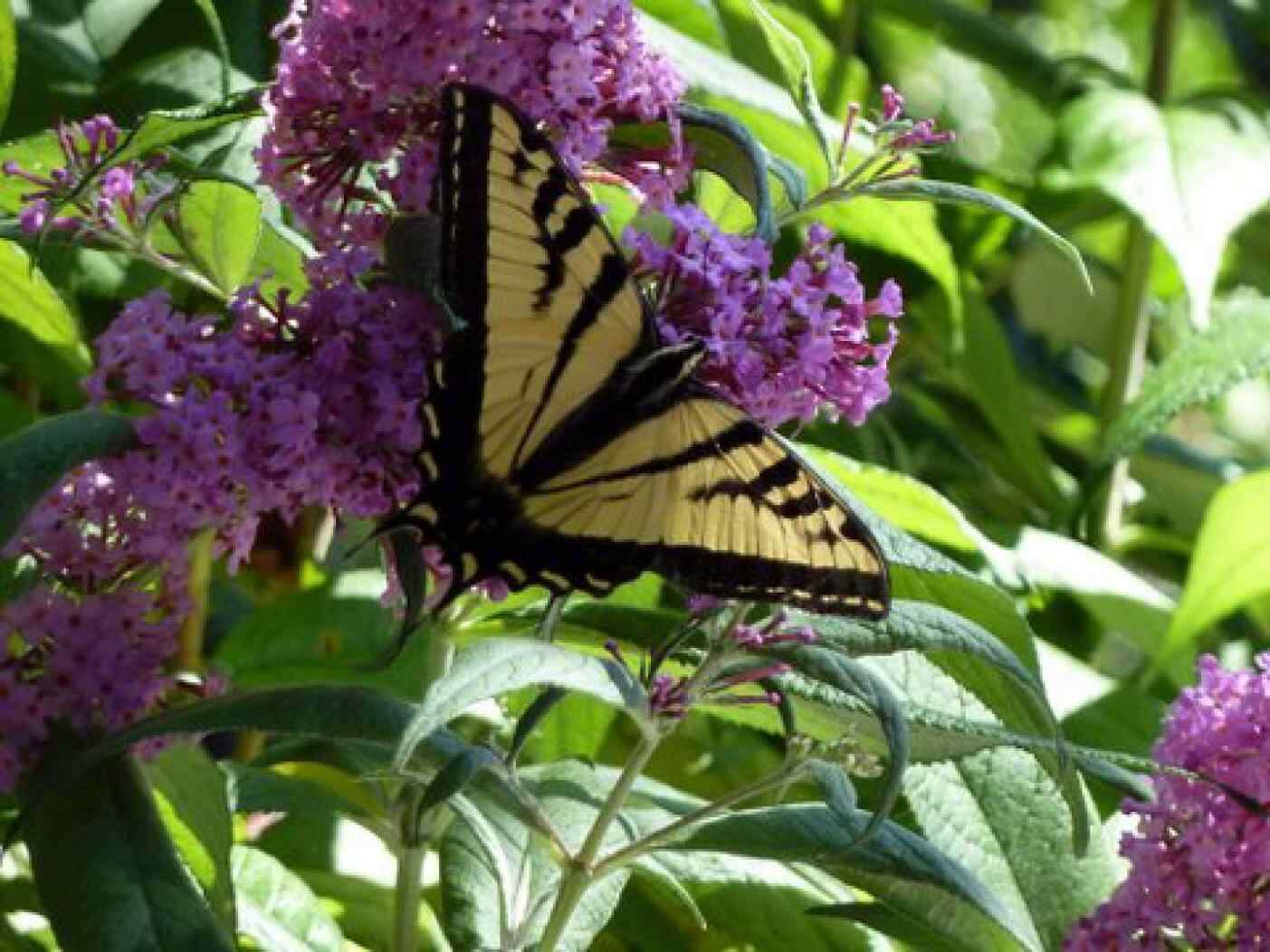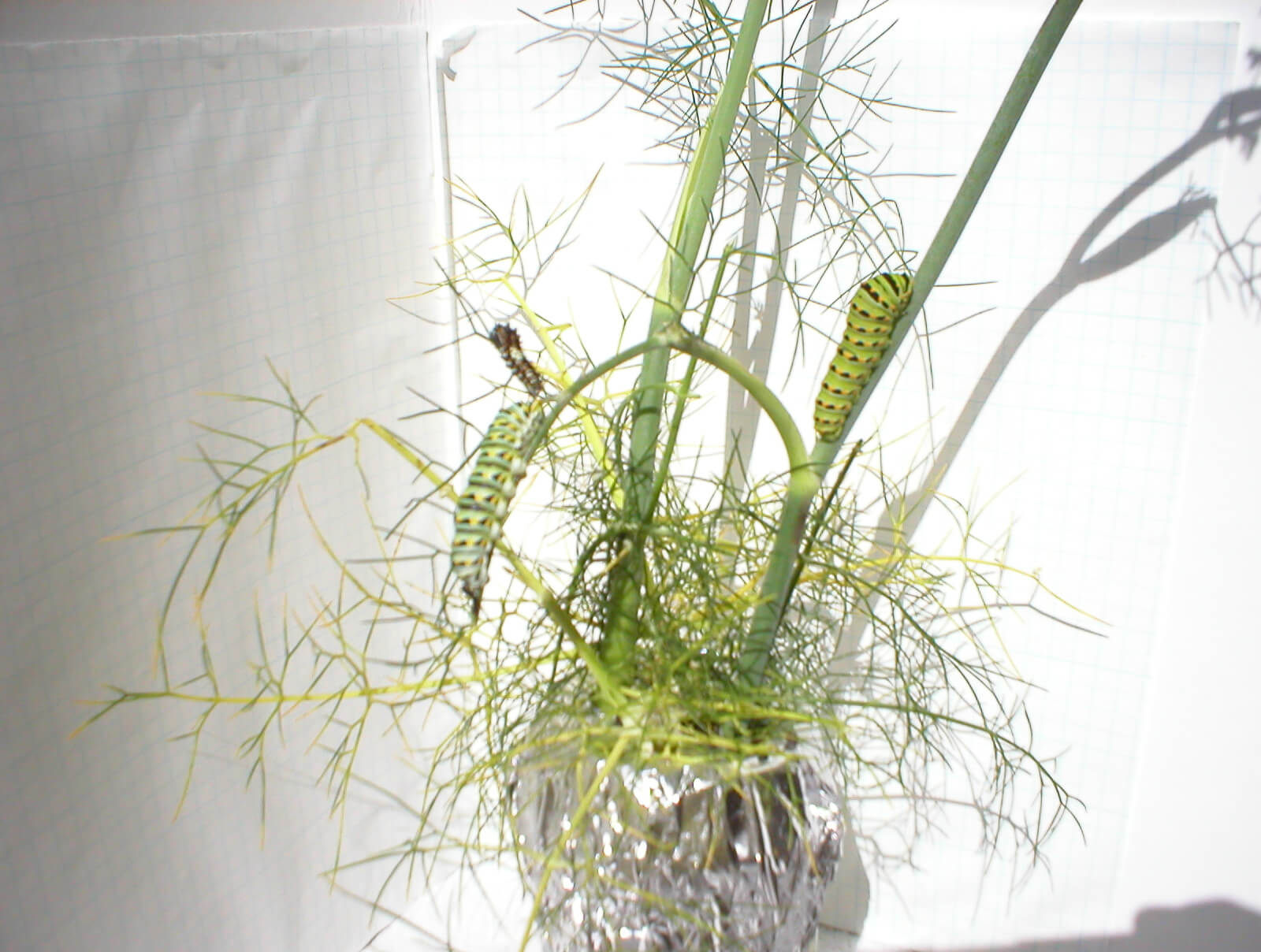Within the family Papilionidae are some of the largest and most spectacular butterflies in the world. Four species are commonly seen in Marin; each one associated with a particular type of habitat. Three are yellow with black markings; the Western Tiger Swallowtail, with a nearly 4″ wingspan is the largest butterfly in Marin; and the Pipevine Swallowtail is the only large ‘blackish’ butterfly in Marin.
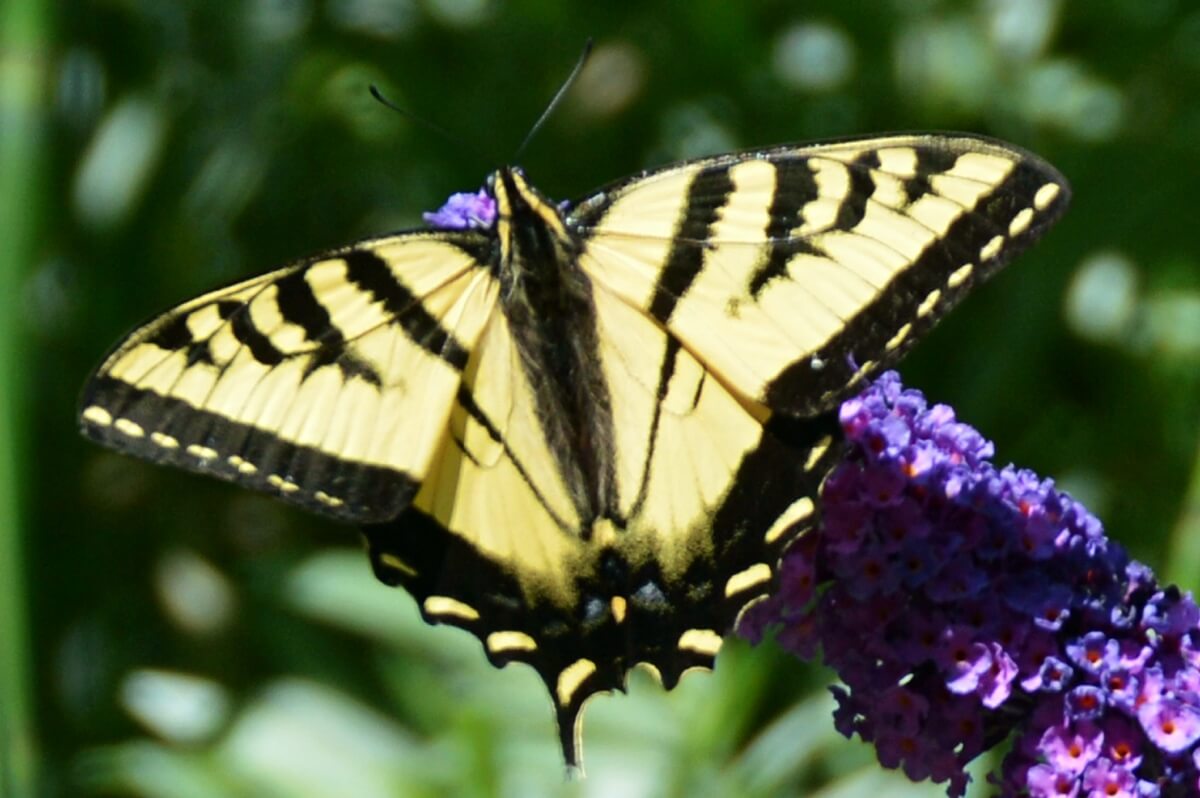
This fairly fresh Western Tiger Swallowtail has already lost one of its ‘tails’.
The ‘tails’ and bright blue and red eyespots that most of the butterflies within this family are adorned with are a form of ‘back to front mimicry’ which helps to confuse visual predators. Birds will strike at these eyespots, and often get nothing more that a beakful of wing, leaving the vital parts of the butterfly unscathed. Butterflies can manage pretty well with up to two thirds of their wings missing!
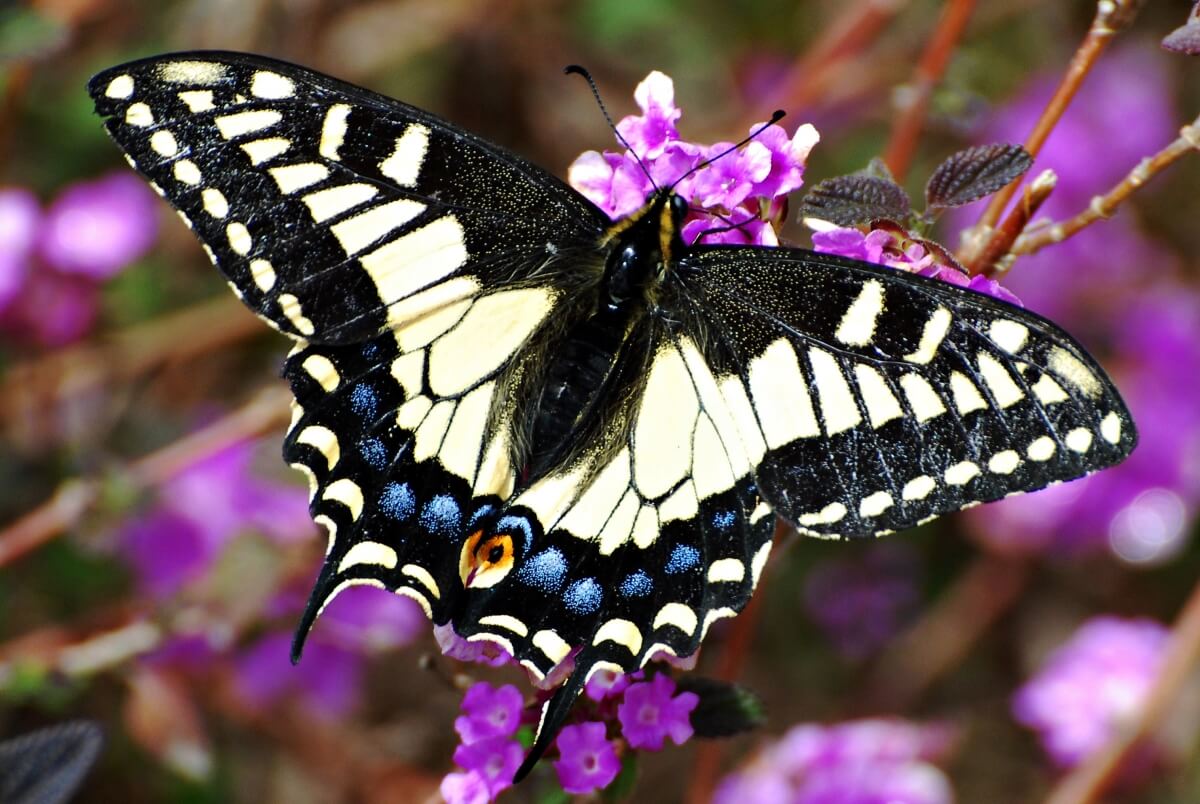
This is a perfect specimen of the Anise Swallowtail.
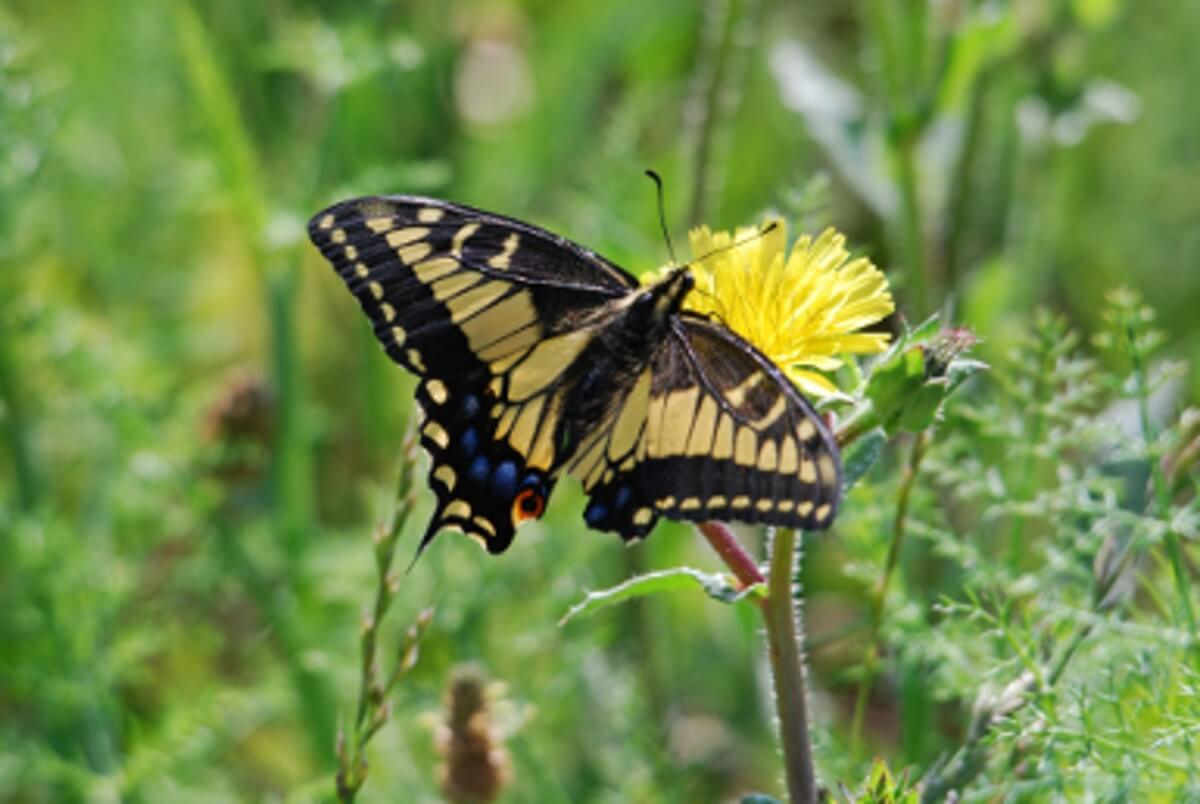
This Anise Swallowtail has suffered a lot of damage to its wings, but it can still fly.
Characteristic Traits in CommonThere are a number of other characteristic traits shared by members of this family; with the exception of the Pipevine Swallowtail (details on this species follows). Eggs are dome shaped or smooth and globular, and usually laid singly on the host plant. The larvae are smooth skinned, and greenish; early instar larvae often mimic a bird dropping; and the larvae all possess ‘osmeterium’.
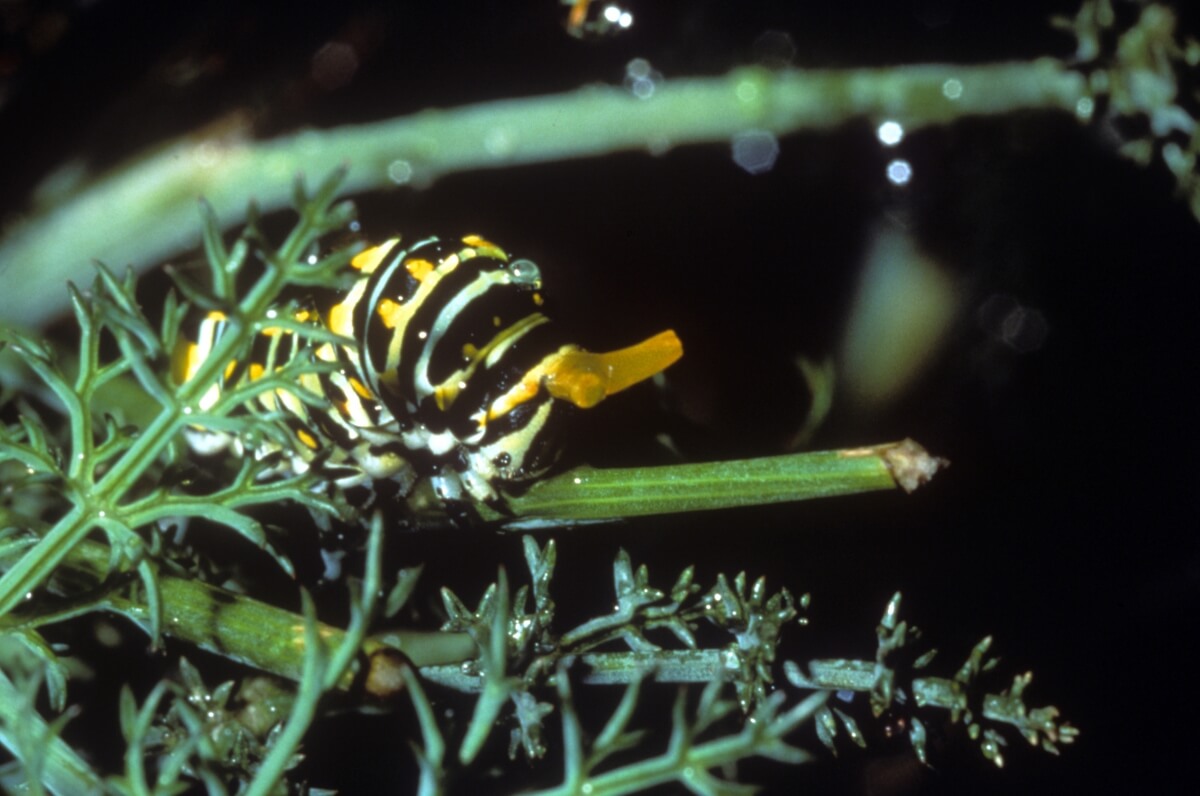
This Anise Swallowtail larva has everted its osmeterium, which releases a foul odor thought to help deter predators. (Photo by Bob Stewart)
The osmeterium is an eversible organ, concealed in a slit behind the head. If the larva is disturbed it everts the bright orange-colored osmeterium, and discharges a foul scent. The scent the larvae discharges upon eversion of its osmeterium comes from a secondary biochemical compound produced by a number of plants in the carrot family (Apiaceae). The biochemical compound is not essential to the life of the plant; but necessary to elicit feeding by the larvae. The osmeterium is just one of the defenses against visual predators; in the case of birds, most of which do not have a highly developed sense of smell, it might be more the startling effect of a sudden change to the form of the larvae that affords some protection.
Caterpillar Silk
Another form of protection for all butterfly larvae is to simply drop off a plant to escape a threatening predator. Sometimes they will do this by dropping off on a silk cord, which they manufacture, and then pulling themselves back up to the plant once the threat has passed. Other times you can find them, curled into a tight ball on the ground at the base of the plant, ready to climb back up onto the plant when the threat has passed. Larvae also create silk to make a ‘holdfast’ which enables the larva to simply ‘walk out’ of the old molted skin; and they use their silk to create a ‘button’ from which the pupa hangs, and in some species, like the Swallowtails, both a ‘button’ and a silken ‘girdle’ to support the pupa.
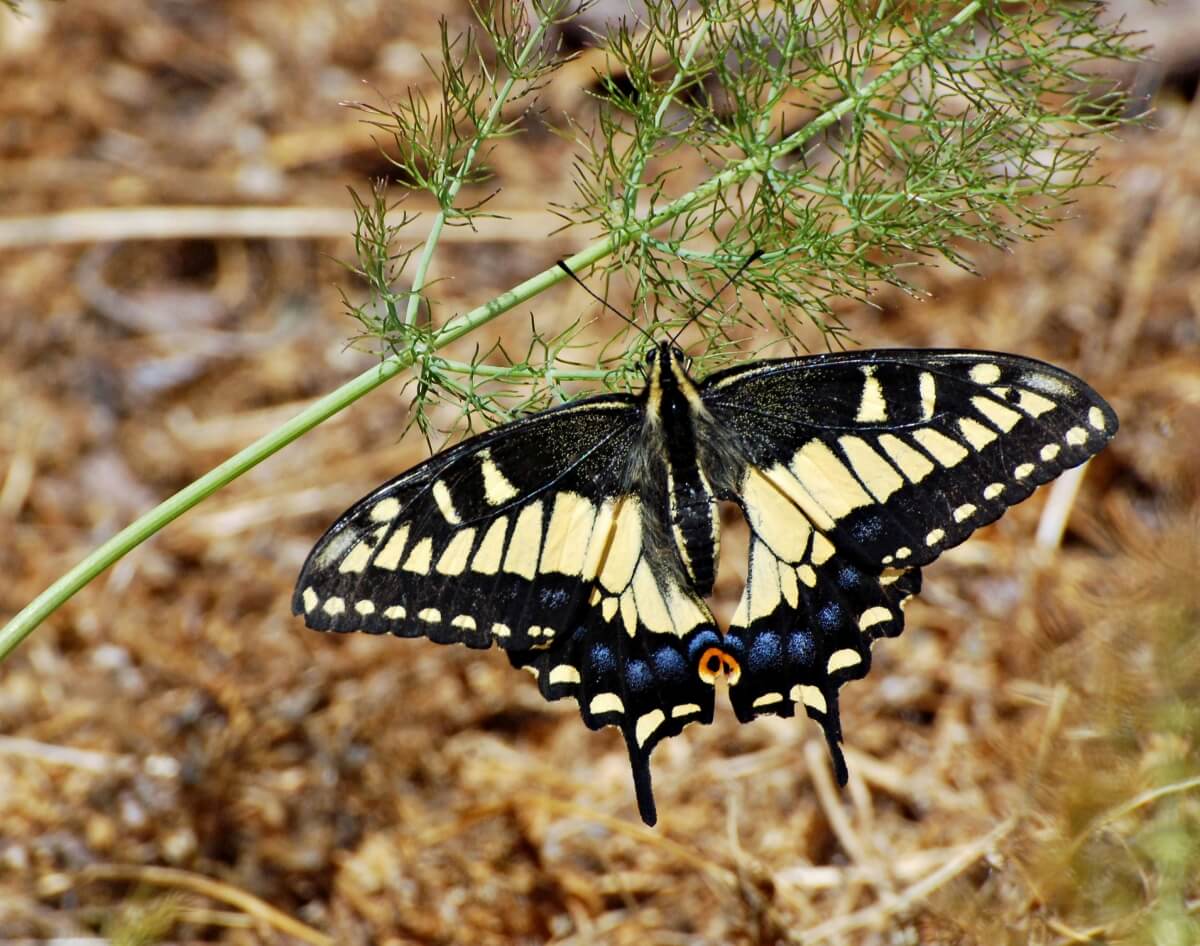
Anise Swallowtail on Sweet Fennel (Foeniculum vulgare).
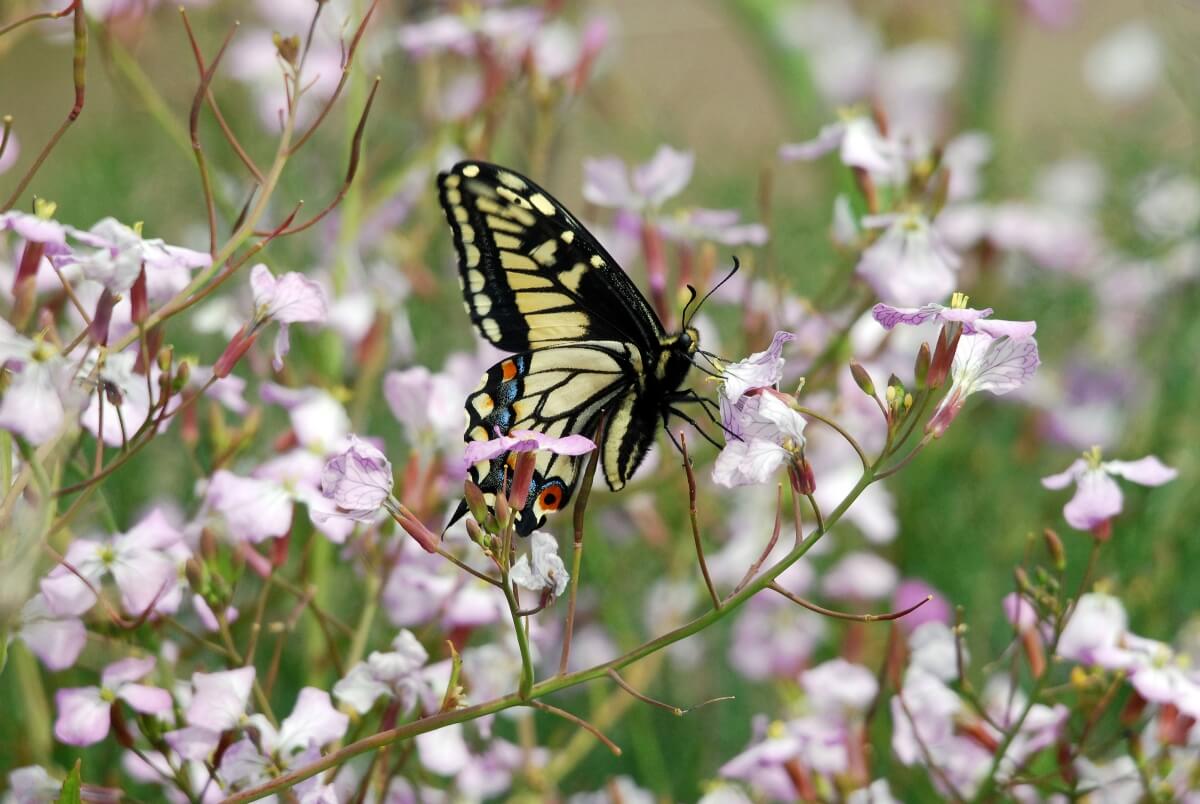
Anise Swallowtail with the beautiful eyespots on its underwings showing while it sips nectar from a wild mustard flower.
Anise Swallowtail – Papilio zelicaon
Before settlers dramatically changed the California landscape this butterfly would find its larval host plants in grasslands and at the edges of the great marshlands. Now the Anise Swallowtail is most commonly seen in disturbed fields and urban areas, and is easy to provide for in a garden. With a wingspan of about three inches, it is the considerably smaller than the other two yellow swallowtails; and it looks ‘blacker’. The leading edge of the front wing is almost solid black, and the yellow markings are more blocky, rather than stripy, as in the other two yellow swallowtails.
Introduced Host Plants
The Anise Swallowtail larvae feed on plants in the carrot family (Apiaceae) which contain certain essential oils known as anisic aldehyde or anethole; biochemicals that a larva is able to convert to a butyric acid which smells like rancid butter when released by the osmeterium. Carrot family plants that don’t produce these biochemicals, such as Sanicles, are never used as host plants.
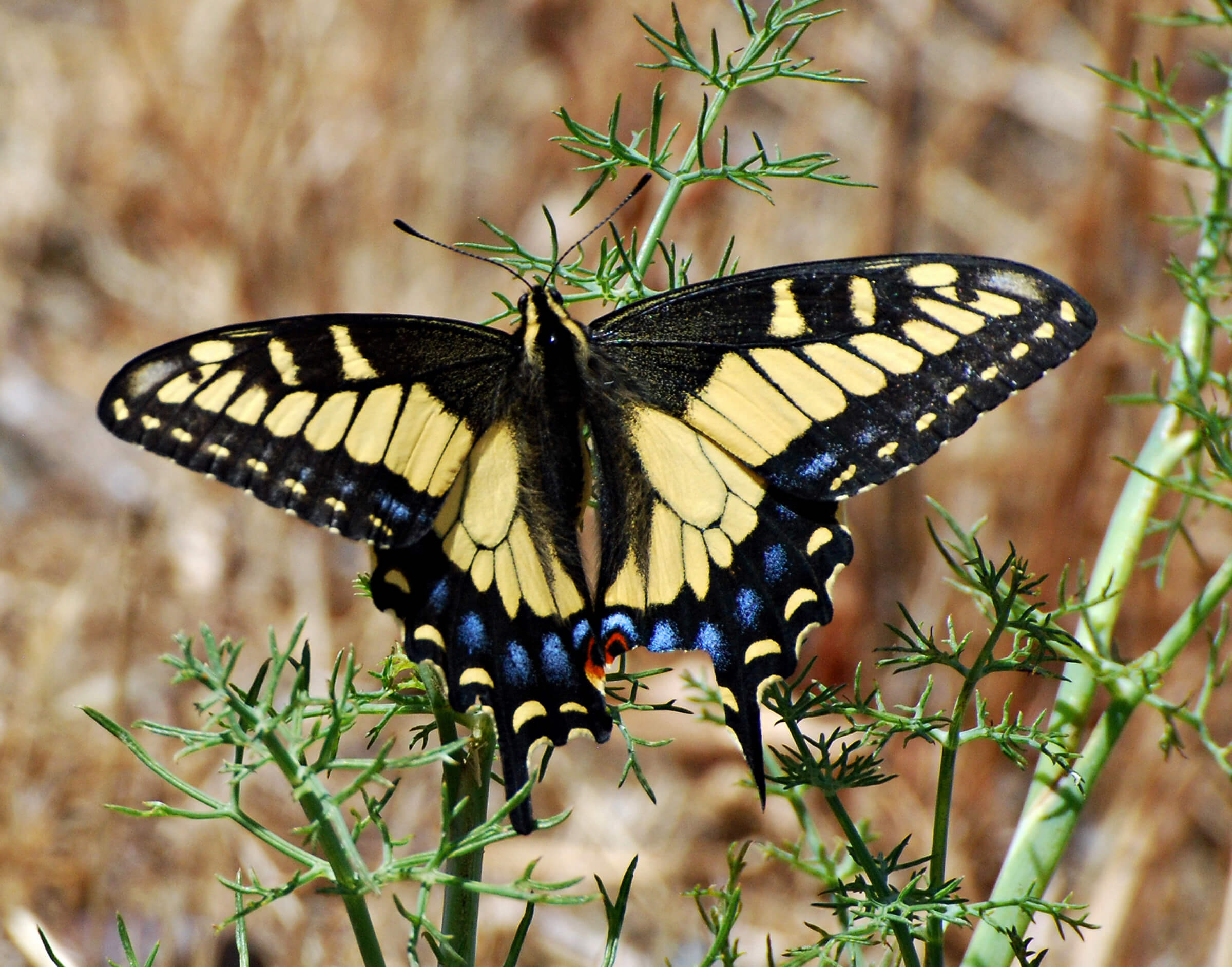
The female butterfly can test the chemical composition of a plant. This Anise Swallowtail is on Sweet Fennel.
The adult female butterfly has chemical receptors in its tarsi which enable it to test the chemical composition of a plant in order to determine if it is a suitable host for the larvae. Once this is confirmed, the female lays her egg, usually on the underside of a leaf. The behavior is really distinctive, and easy to observe; she curls her abdomen around, stretching a bit to carefully place the egg in an almost invisible place. But that is only true for human eyes; all sorts of arthropods and insectivorous birds search through plants for little tidbits like butterfly eggs. And that is only the first part of the life cycle; it is estimated that perhaps one in hundreds of eggs laid by each female actually makes it all the way through all the stages to adulthood!
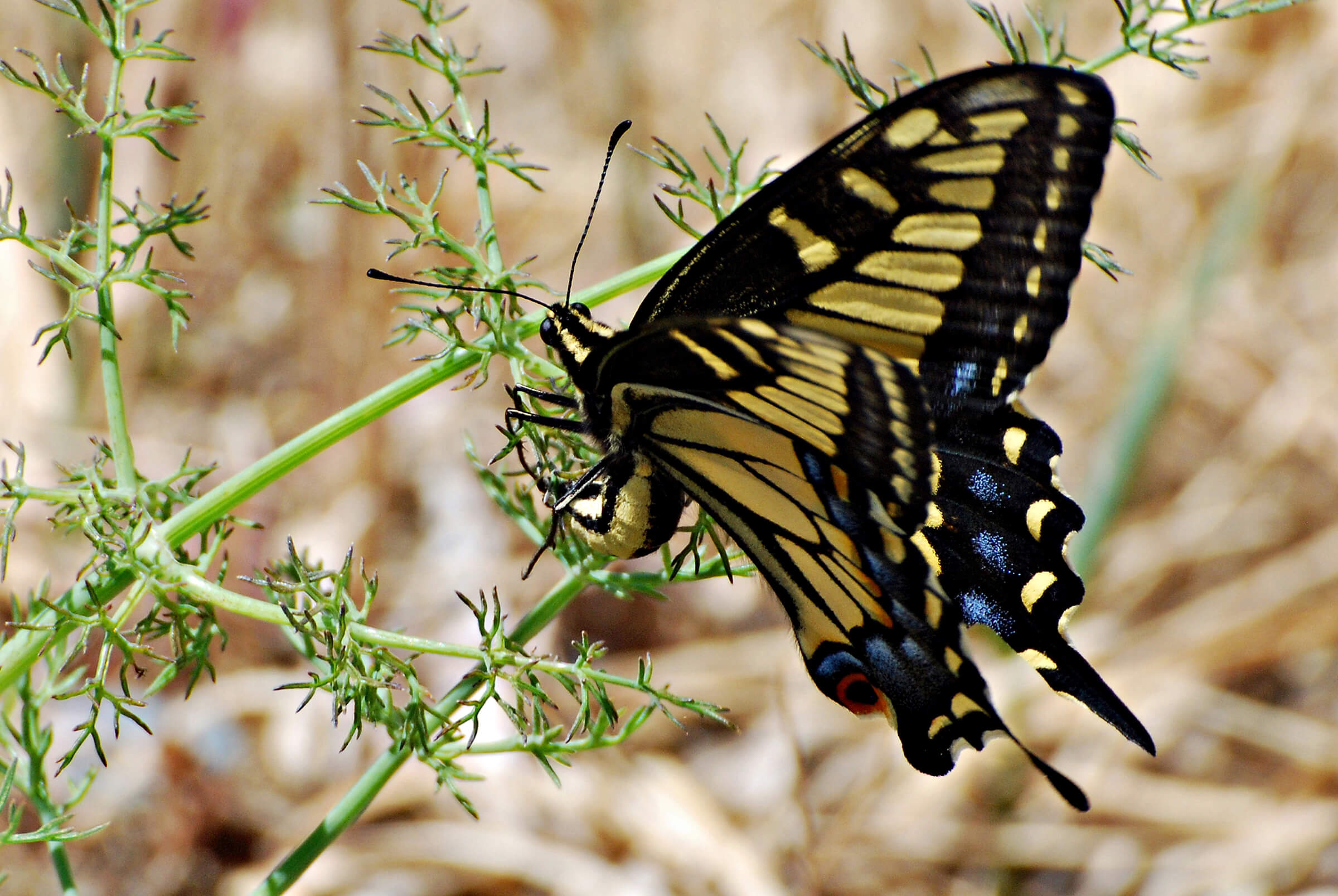
This female is laying an egg; affixing it to the underside of one little leaflet on the Fennel.
The Anise Swallowtail may be more common now because it often associates with an introduced plant, sweet fennel, (Foeniculum vulgare) also commonly called ‘anise’. It was brought to this country as a kitchen garden plant, which then escaped cultivation, and is now widespread in many parts of California. The plant has been in California since the days of the Gold Rush, and as early as 1850 lepidopterists noticed larvae feeding on introduced fennel.
Sweet Fennel is a perennial that tends to be a large plant, and is often found in large drifts; seeding itself into disturbed ground, in vacant lots and along roads and highways. In an effort to control its spread, the plant gets cut back hard by road crews, but then it simply re-grows, providing all sorts of fresh new growth for larvae to feed on. Experiments have shown that this plant is intrinsically more attractive to ovi-positing females than native larval host plants; and the abundance of leafy growth, as well as flowers and immature seeds provide a bounty which enables the Anise Swallowtail to produce several broods during the season.
Much as I appreciate all the resources that Sweet Fennel provides for wildlife, I do not grow it in my garden because I’m right next to fairly pristine wild lands and I don’t want to give this ‘weed’ an opportunity to colonize still more land. Another introduced plant that the Anise Swallowtail will sometimes lay eggs on is Poison Hemlock (Conium maculatum), but only early in the season while green growth persists. This plant grows in moist conditions, often close to streams or marshy areas, and is so poisonous that I doubt anyone tries to grow it in a garden.
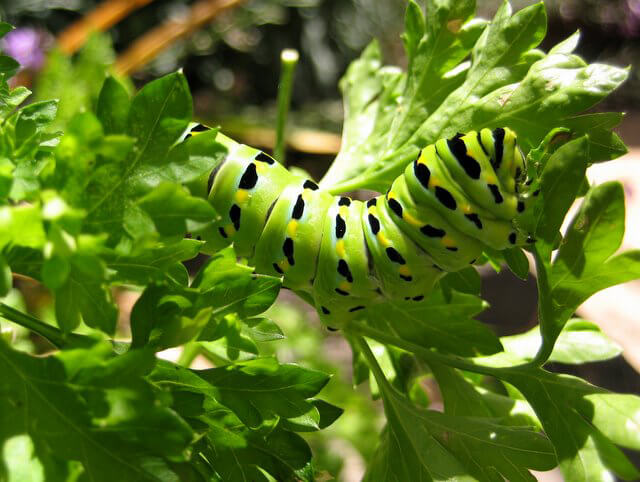
This Anise Swallowtail larva is feeding on Parsley.
A kitchen garden is cornucopia of possible host plants for this species. Parsley, dill, carrots, celery, parsnips, caraway, true anise (Pimpinella anisum) and of course, fennel; all are edible plants that a female will lay eggs on. Bulbing fennel, and ‘bronze fennel’ are a better choice for kitchen gardens, since they are not as prone to reseeding as sweet fennel. Queen Anne’s Lace, or ‘wild carrot’ ( Daucus carota) is an introduced flowering plant that is also sometimes used as a larval host plant, as is Rue (Ruta graveolons), a medicinal plant.
Native Host Plants
California native host plants are either found in grasslands or growing closer to water courses and marshlands. Yampah (Perideridia spp.) and Hog Fennel (Lomatium dasycarpum) are grassland plants; fresh new foliage emerges early in spring, and seeds are set by summer. In wetter areas leafy growth persists right through summer; Cow Parsnip (Heracleum lanatum) and Water Hemlock, (Cicuta spp.) and Lovage (Ligusticum apiifolium) are sometimes used. Other native plants sometimes used as larval hosts are species of Tauschia, Oenanthe, and Angelica.
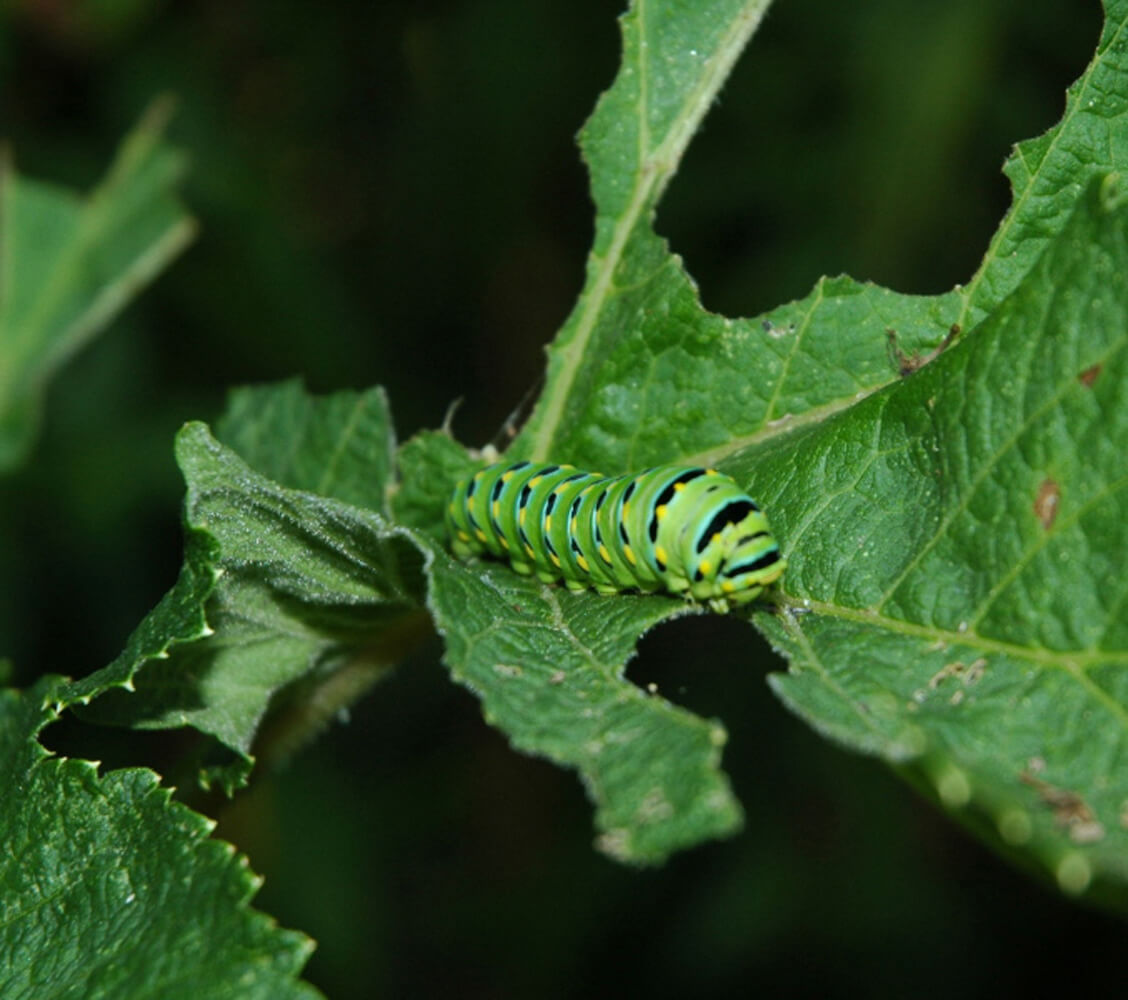
Cow Parsnip is sometimes used as a larval host plant.
Raising Larvae Indoors
I’ve raised many Anise Swallowtail larvae; I often bring them into the house just to protect them from predators. I have both native and non-native carrot family plants growing in my garden, but most often the larvae show up on dill or parsley. When I’m picking these herbs to cook with, I’m in the habit of checking carefully for eggs or larvae first. No matter what plant I find the larvae on, they seem to transfer readily to feeding on parsley; which is great, because organically grown parsley can easily be purchased.
These larvae were raised indoors on Fennel. There are two different instars; the smallest one is only a few days out of the egg, and already about 20 times larger than when it emerged from the egg. The graph paper in the background is a ¼ inch scale.
Raising larvae indoors requires regular provisioning of fresh plant materials for them to feed on; and thus disturbing them a bit on a daily basis. Interestingly, I’ve noticed, that hand-raised larvae soon get used to this disruption, and seem to get lazy about using their smelly warning system!
The newly emerged larvae are so small they can easily hide amongst the thread-like leaflets of dill or fennel. They are smooth-skinned, and mostly black, with a white ‘saddle’ in the middle; nicely resembling inedible bird poop! Their coloration changes slowly to a stripy yellow and green pattern as the larva grows; these colors are good camouflage amongst the leaves and flowers; but the larvae are perfectly edible, so they often disappear when left in the garden.
Pupation…
The larvae grow rapidly; eating, pooping, and resting in between each molt. They will be inactive for a day or so before a molt; and then after the molt they do nothing but eat until the new skin is nicely filled out again. In about three weeks they are ready to pupate. The mature Swallowtail larva creates a silken button, which the cremaster is secured to, and a silken ‘girdle’ which will hold it in place around the middle. The pupa actually forms under the skin of the larva, which will remain in the pre-pupa stage for about a day.

Anise Swallowtail larva in the pre-pupal stage. (Photo by Phil van Solen)
When the pupa has formed the old skin splits along the back and the pre-pupal larva – which, at this point, is amazingly nothing much more than ‘cellular soup’ contained within the pupa. The insect is able to wriggle the old skin off, and then the pupal form hardens. The pupa is fixed with the head end up; it can be colored either green or brown, depending on the background surface. Watching all this happen right in front of your eyes is exactly why people go to the trouble; it really is an amazing process!
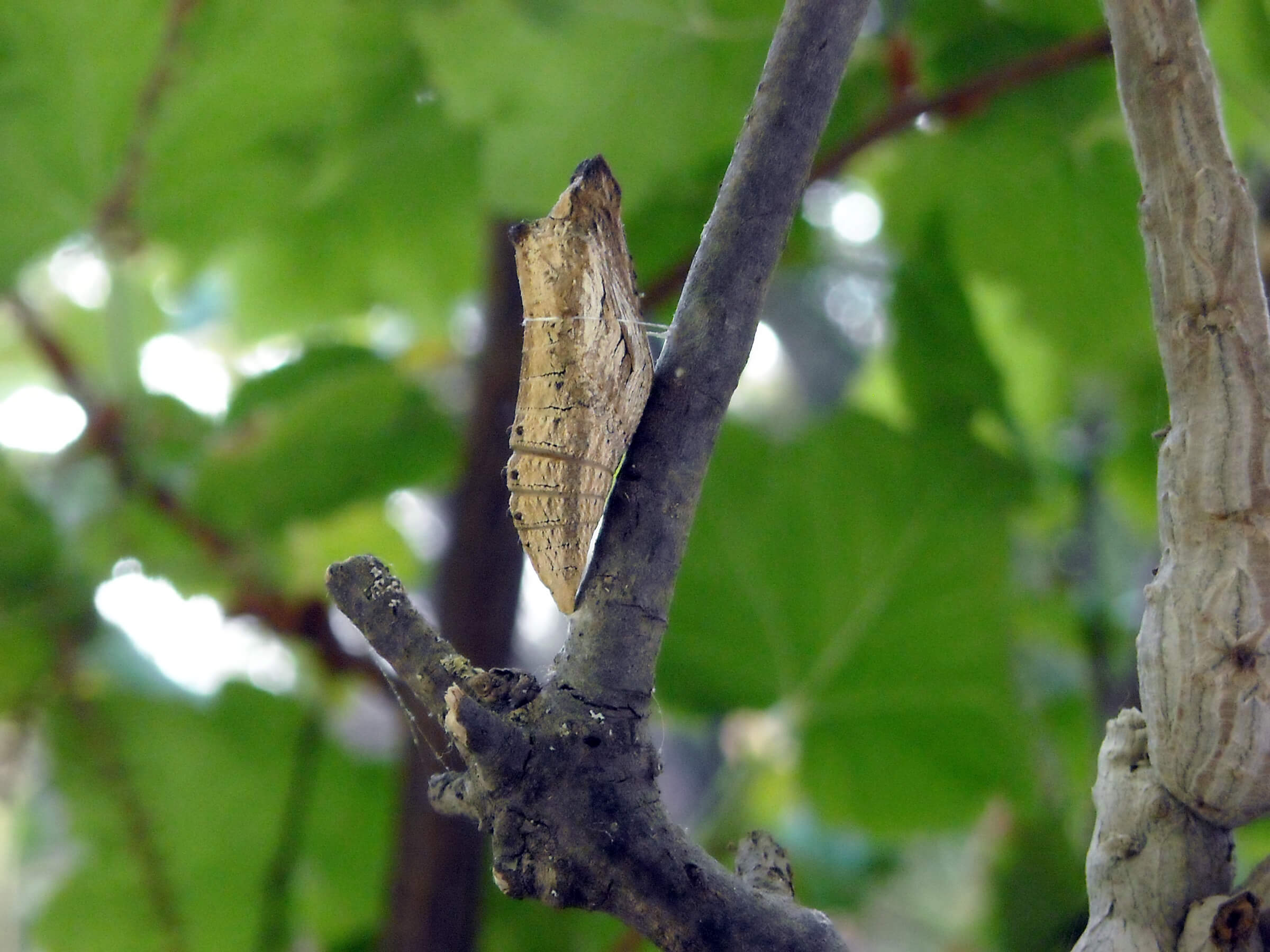
The Swallowtails pupate in a head-up position.
…and Diapause
While raising the larvae is fun; at the pupal stage it can become a bit frustrating (especially for children) because these butterflies often go into diapause at this stage. When hand-rearing these caterpillars I place a variety of twigs and sticks in the container for them to pupate on. Then I’m able to put a little tag with the pupation date on the twig close to the pupa. In my experience, a few will eclose from the pupa after about two weeks; but many don’t, and these, I keep in an un-heated room, and check on them regularly in spring and summer. I’ve personally witnessed a perfectly formed Anise Swallowtail eclose from the pupa after several years! Five years is the longest diapause I’ve recorded, but I’ve read that it can be as long as seven years. Amazing!
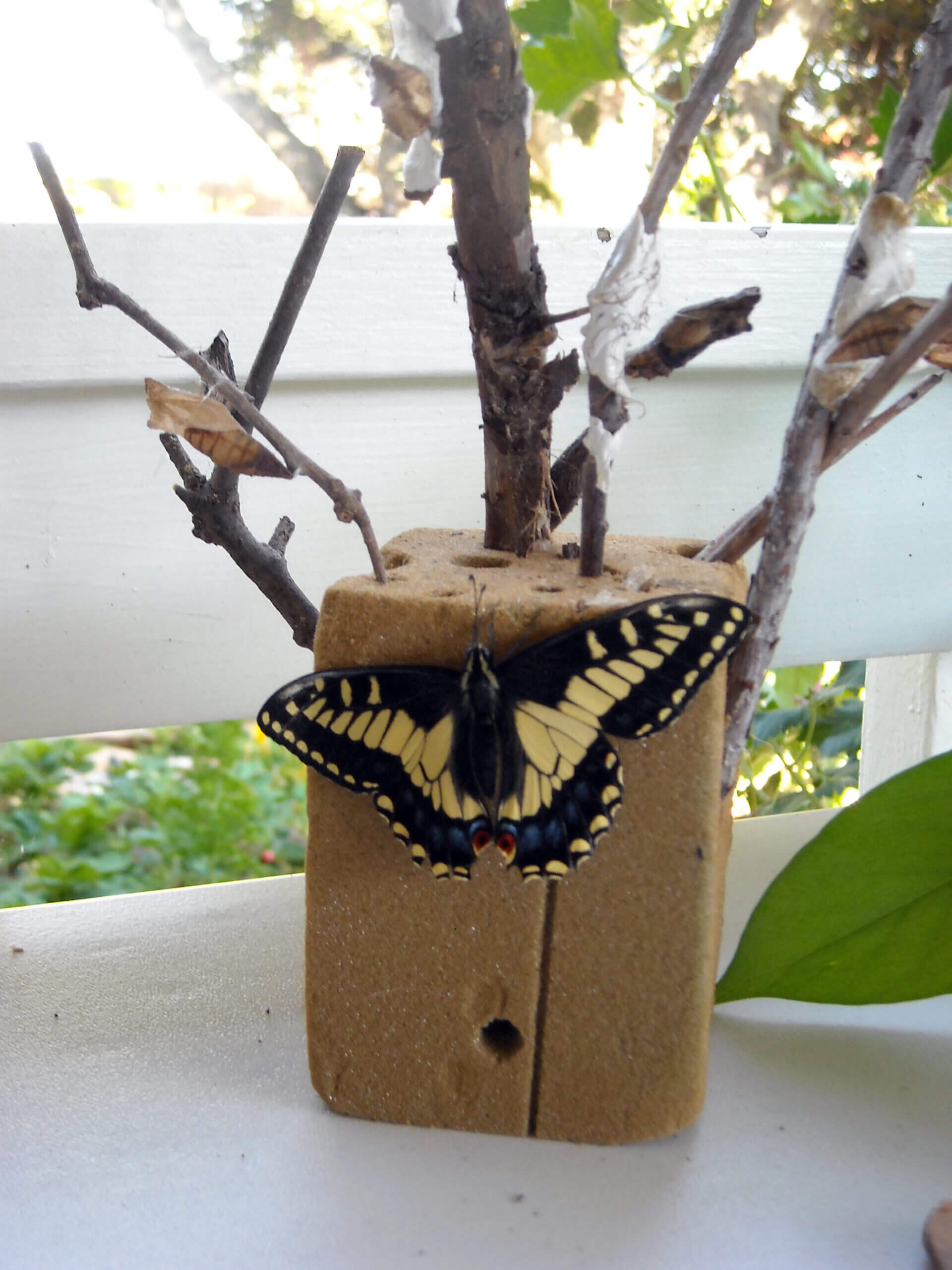
This Anise Swallowtail eclosed from the pupa on the left side – coming out of a diapause that lasted several years.
Diapause in the pupal stage is thought to be a ‘risk-spreading’ strategy in an environment that may or may not provide enough host plant material for another generation right away. It’s like an insurance policy for the species; individuals can be mature and ready to breed when optimal conditions exist.
Swallowtails Frequenting Riparian Areas
The Western Tiger and the Pipevine Swallowtail, which actually look and act very differently, are often seen around watercourses, because that’s where their native host plants grow. Willows, Alders, and Cottonwoods are common streamside trees, and all support larvae of the Western Tiger; Sycamores and Ash, both native and non-native species, are also used. The California Pipevine commonly grows in riparian zones, and it is the only host plant of the Pipevine Swallowtail. The plant does have a vining form, and usually climbs through shrubs and up into trees, but in Novato I see it growing as a spreading groundcover under bay trees.
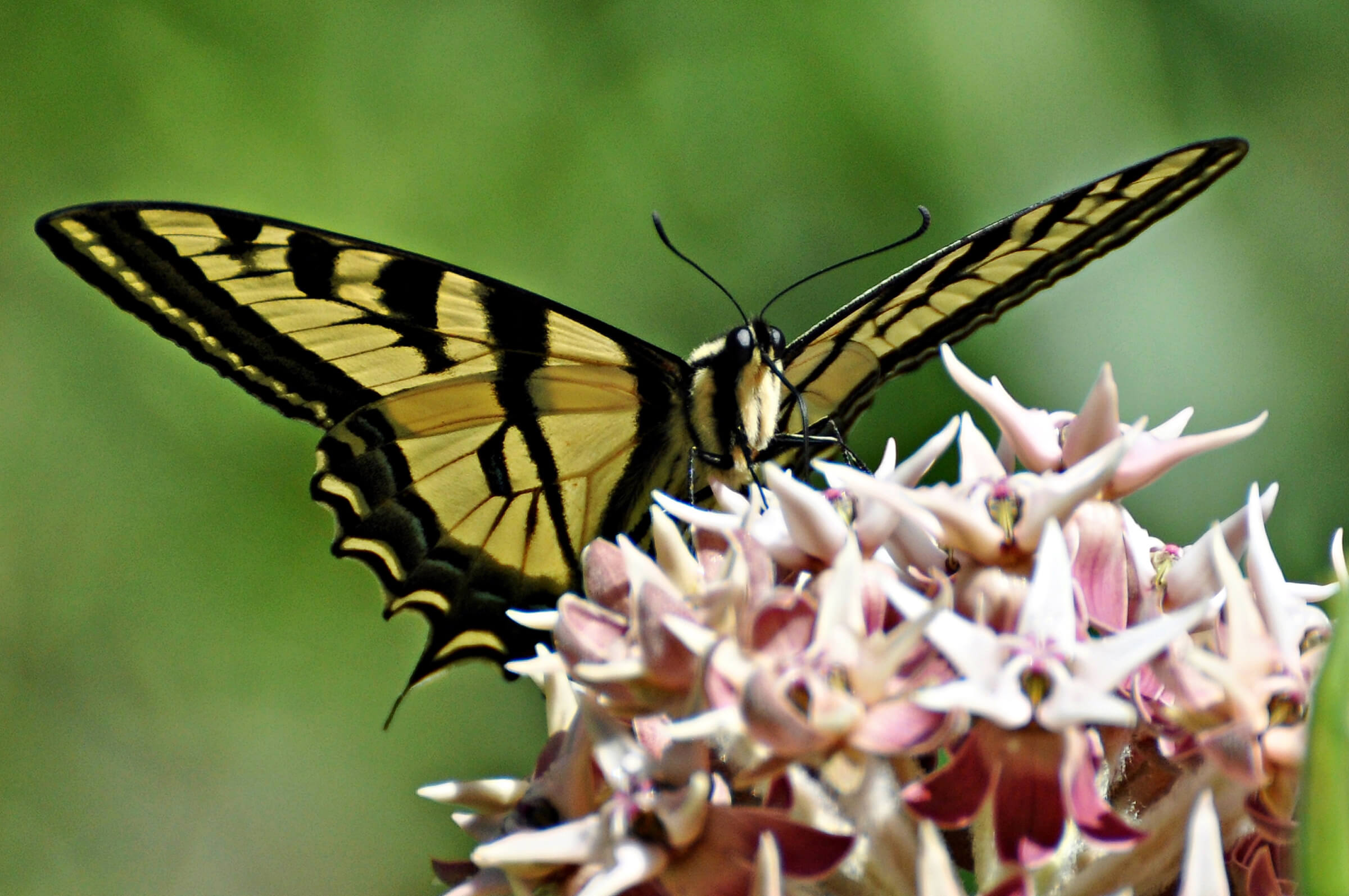
A Western Tiger Swallowtail sipping nectar from the flowers of Showy Milkweed.
Western Tiger Swallowtail – Papilio rutulus
This is probably the most spectacular butterfly you will see in Marin County; it is the largest, with a wingspan of about four inches, and the deep yellow color, striped in black, really catches the eye.
It flies high through tree tops and along streams; but also comes to flowers for nectar. Buddleias and Zinnias are favored in gardens; Milkweeds and Thistles are also sought out. Other good nectar plants are Yerba Santa (Eriodictyon californicum), Buttonbush (Cephalanthus occidentalis), and California Buckeye (Aesculus californica).

The underwing of a Western Tiger Swallowtail.
The Western Tiger will also sometimes lay eggs on Prunus species trees, many of which are common fruiting trees, such as Almond, Cherry and Peach. Sometimes the native Holly-leaf Cherry (Prunus ilicifolia) will be used to host larvae. Sycamores and Ash, both native and exotic species are hosts, and trees that can be planted in a garden; but even if the larvae are feeding on them it’s rare to see them.
The caterpillars usually stay high up in the trees, and are also quite spectacular! The later instar larvae have large inflatible eyespots towards the front end of the body, which supposedly mimic a snake’s head, and presumably warn off visual predators.
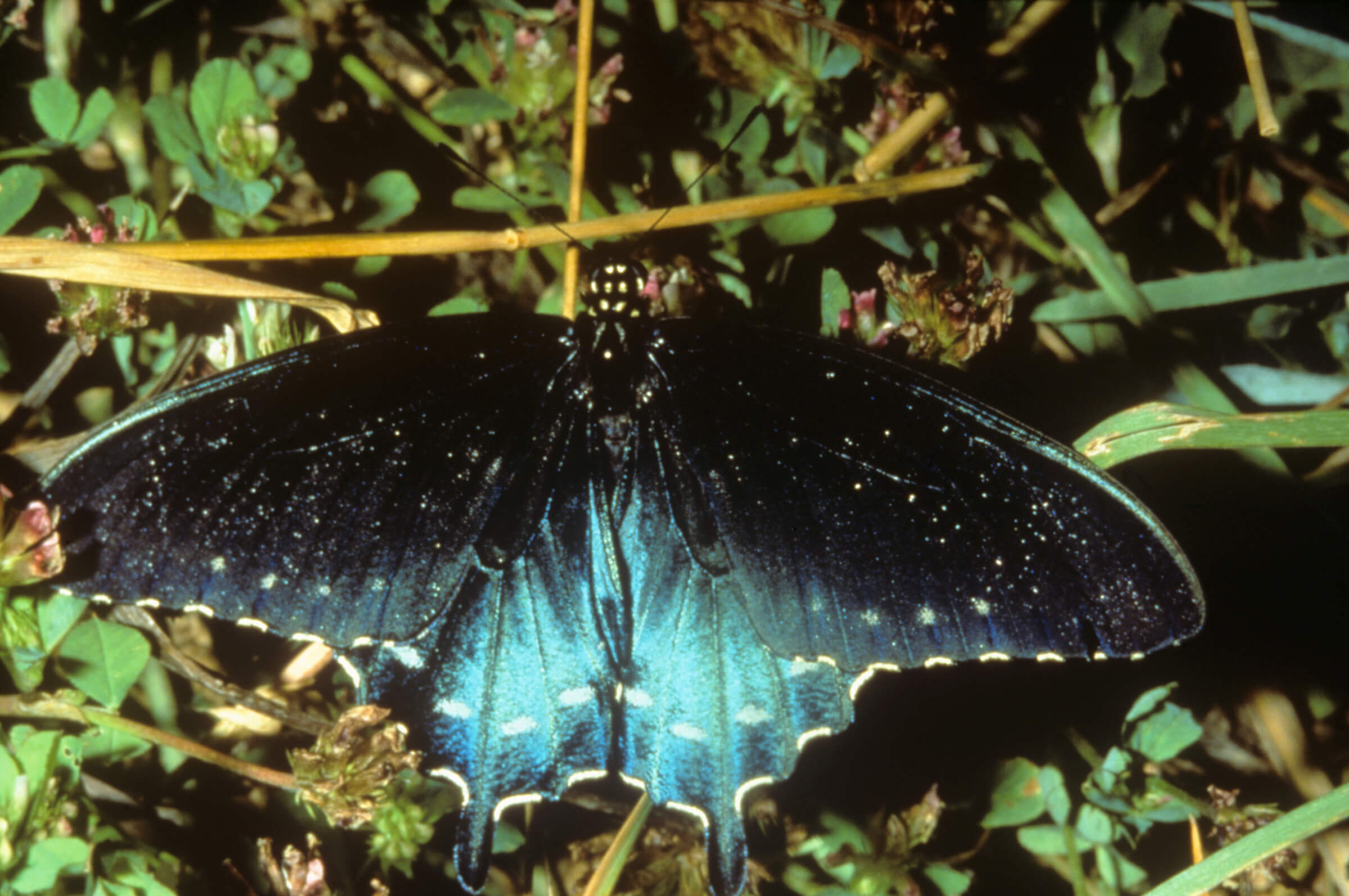
The Pipevine Swallowtail shows a beautiful array of bluish colors in the right light; when flying by, it looks almost black. (Photo by Bob Stewart)

The underwings of the Pipevine Swallowtail display the typical eyespots of this family. (Photo by Bob Stewart)
Pipevine Swallowtail – Battus philenor
This is another butterfly that is easy to identify; an iridescent bluish-turquoise color shimmers over really dark wings. White spots adorn the top wings and the body; on the underwing the large eyespots are orange. The larvae also stand out; they are a dark color with lots of fleshy red ‘tubercules’.
Monophagus
This is one of the most specialized of the native butterflies; it uses just one host plant, California Pipevine (Aristolochia californica). The pipevine produces toxic alkaloids, called aristolochic acids, which the butterfly uses to great advantage. The larvae consume the toxic alkaloids as they eat the foliage; in fact they munch on the same leaf for quite a while because apparently feeding stimulates the plant to increase the chemical defense. The larvae sequester the toxins in their body; the toxins are passed on to the adults; and the females transfer the toxins to the eggs!
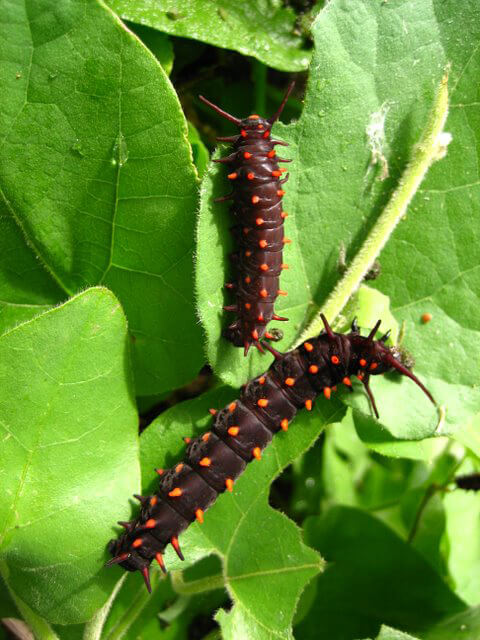
Pipevine Swallowtail larvae feeding on the California Pipevine. (Photo by Nancy Hanson)
Warning Colorations!
The eggs are brick red and laid right at the growing tip of the vine; but only on vines that are climbing, and on tips that are well above the ground. The eggs are laid in clusters and the red color is a warning that they are poisonous. The larvae are also warningly colored in black and red; they are also gregarious, and since they feed in rather exposed places on the plants, maybe several individuals together show the dangerous color more clearly. This coloration offers protection against visual predators, like birds, but does not protect them from invertebrate predators or parasites.
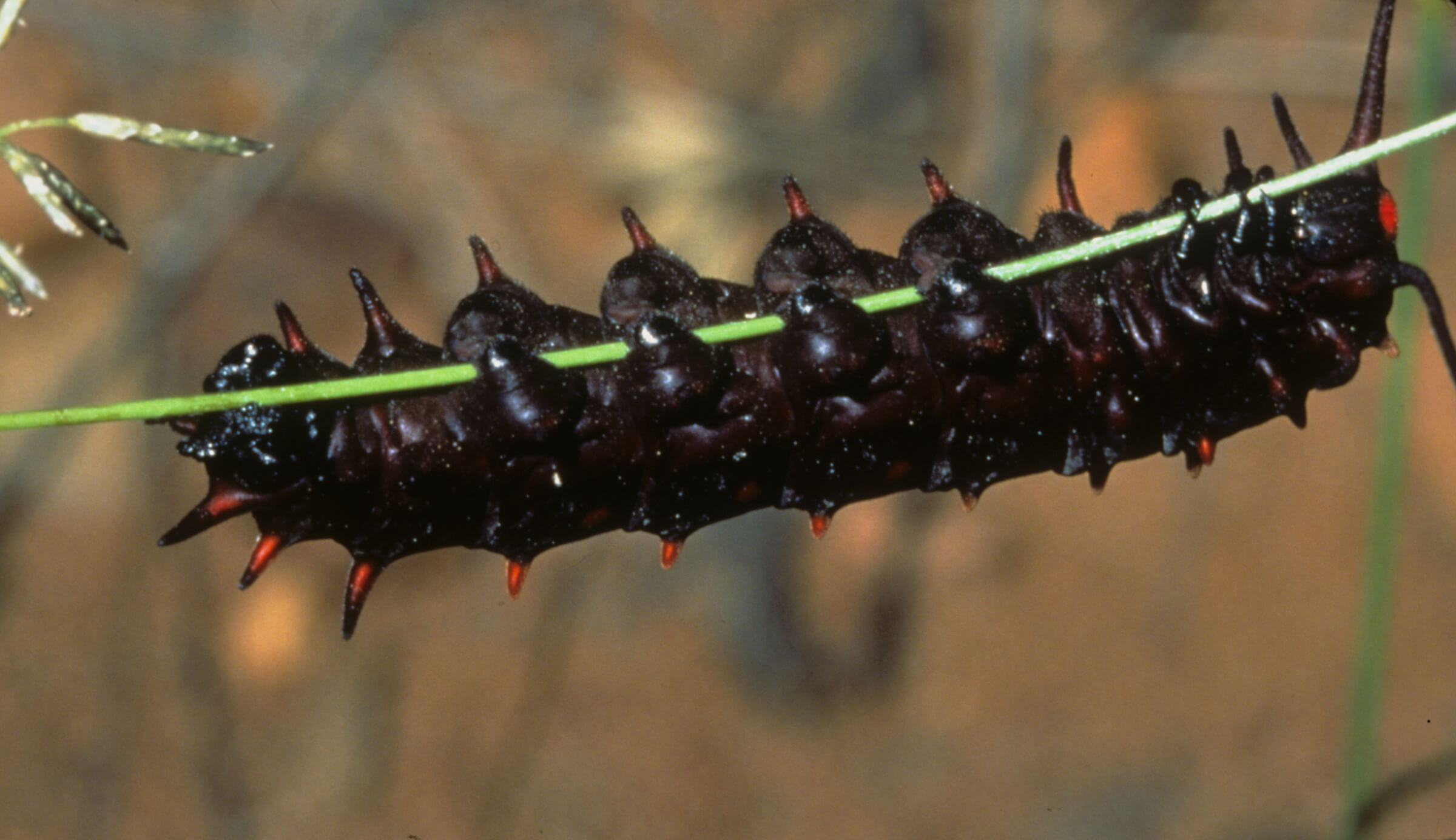
In this photo of the Pipevine larva it is easy to see the ‘prolegs’ which enable the caterpillar to hold on no matter how much the plant might be moving around. (Photo by Bob Stewart)
The Pipevine adults wander a bit; I’ve seen them flying through my Oak Woodlands, rather far from the nearest riparian forest. I have planted California Pipevine in my garden; but it is a plant that takes a long time to establish, and it takes several established plants to provide enough biomass for a female to consider depositing its eggs on it.
Though the adults live just one month they can usually be seen flying any time in summer or fall. Summer populations are mostly males, but the fewer females are often mated and ready to oviposit if they find the right conditions. Pipevines tend to stop growing in early summer; but if there is damage to the vine, perhaps from a fire or by being severely cut back, they regenerate quickly, and then the females are ready to lay eggs on all the tender new shoots.
Bringing the Larvae Indoors
I did raise the larvae indoors when I had access to an established Pipevine; tip cuttings hold quite well in water, and just need to be replenished regularly. When the larvae reach maturity they really like to wander before pupating; and that’s when it’s hard to watch them walk endlessly, around and around and around a relatively small container. They do eventually decide to settle down and pupate; and the pupa can be either green or brown, and a certain percentage will go into diapause.
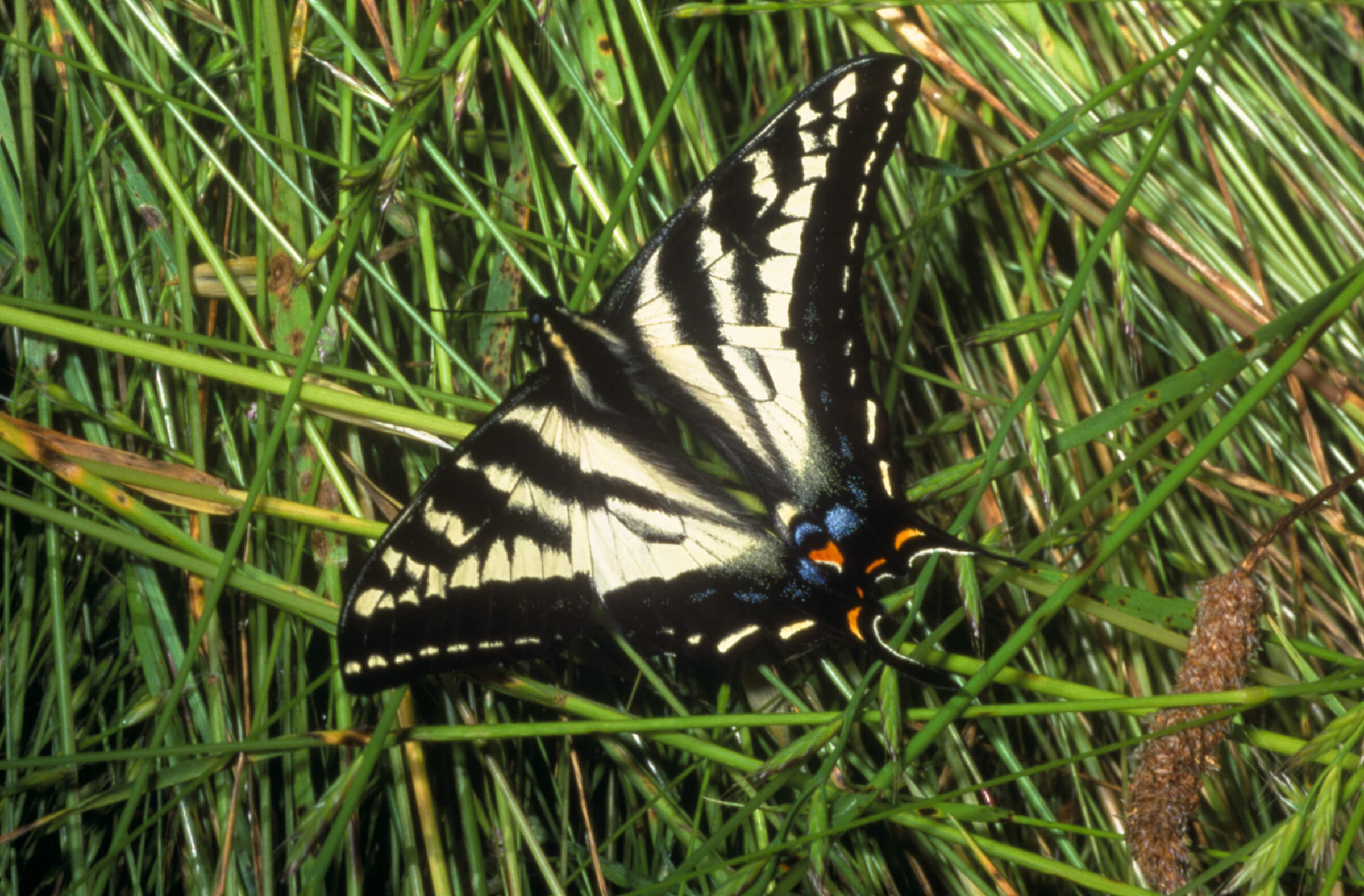
The wings of the Pale Swallowtail tend to be longer and narrower than the otherwise very similar Western Tiger Swallowtail. (Photo by Bob Stewart)
Pale Swallowtail – Papilio eurymedon
This is a butterfly of wild areas; it prefers the dry, rocky canyons and chaparral. The males are very pale, almost white; the females are yellower and resemble the Western Tiger Swallowtail, but have much less yellow between the black striping. The males are ‘hill-toppers’; patrolling the high places on the look-out for females. The males of this species also really like to ‘puddle’; sipping water, and presumably imbibing all sorts of mineral nutrients in the process.
The host plants are Coffeeberry (Rhamnus spp.) and sometimes Ceanothus; Cream Bush (Holodiscus discolor) is also used, and sometimes Holly-leaf Cherry (Prunus ilicifolia). There is only one brood each year, and adults fly just for a few months, usually from March to August. Apparently this species is not known to diapause in the pupal stage.

The early instar larva of the Pale Swallowtail mimics a bird dropping. (Photo by Bob Stewart)
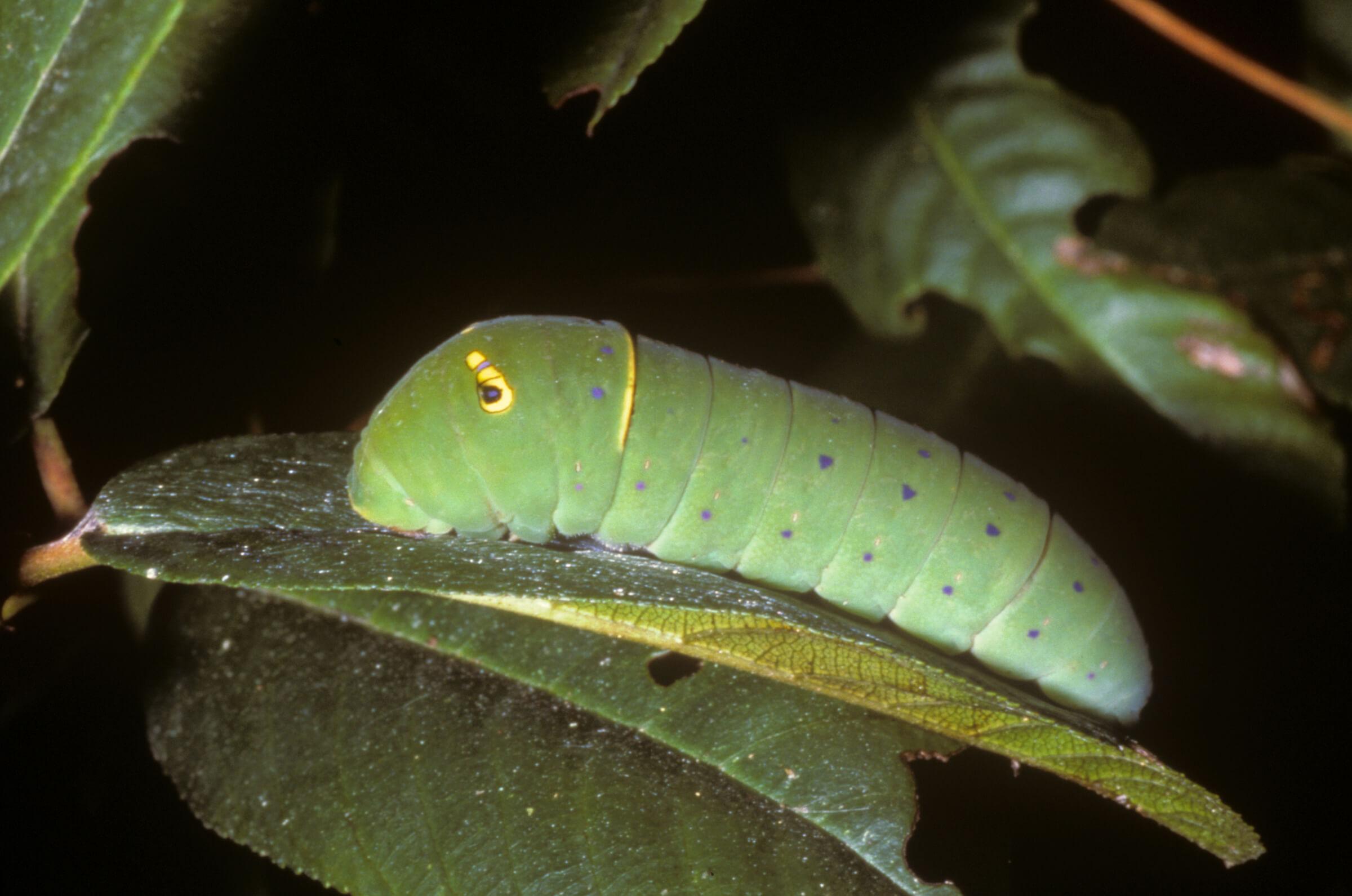
The later instar larva of the Pale Swallowtail display eyespots; presumably to mimic a snake. (Photo by Bob Stewart)
